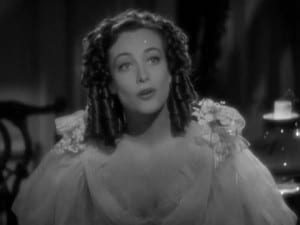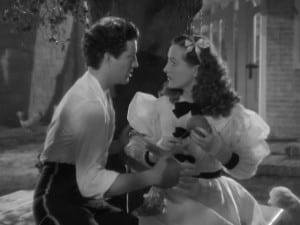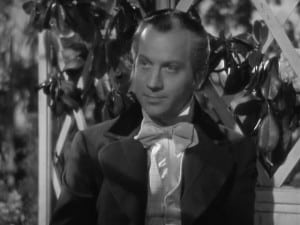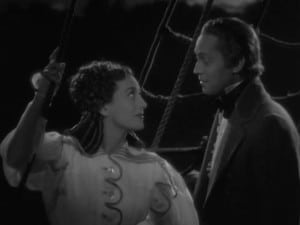At some time during 1936 the powers that were at MGM decided to take perhaps their biggest star of the time, Joan Crawford, and pull out all the stops in putting her in the highest quality production. The subject matter they picked was somewhat odd to say the least.
For Ms. Crawford (technically at this point Mrs. Franchot Tone), the most contemporary star in outlook and demeanor, they chose the historical costume drama The Gorgeous Hussy. Though Crawford had limited experience in period pieces and westerns to date, they were never her strong suit. After the increasingly tepid critical response to The Gorgeous Hussy, Crawford would avoid costume pieces for the balance of her career. In spite of the critical disdain, the film did turn a decent profit for the studio and can definitely not be considered a commercial failure.
In the loosest possible fashion, the film attempts to follow what is known as the Petticoat Affair and its impact on the administration of President Andrew Jackson. Thankfully both the fact that the film is based on a novel by Samuel Hopkins Adams and a rather all encompassing disclaimer at the start of the film let the viewer know to expect little or no resemblance with the historical record. Sadly the actual events would have provided a much more lively basis for a film.
 Sparing no expense, MGM assembled an exemplary cast in support of Joan Crawford’s portrayal of Peggy O’Neal. As her first husband and naval officer Bow Timberlake is Robert Taylor. Jimmy Stewart is sometime suitor Rowdy Dow but his main function is comic relief. Other suitors come in the forms of Franchot Tone as Cabinet member John Eaton and Melvyn Douglas as Senator John Randolph. Capping things off is Lionel Barrymore as Andrew Jackson himself.
Sparing no expense, MGM assembled an exemplary cast in support of Joan Crawford’s portrayal of Peggy O’Neal. As her first husband and naval officer Bow Timberlake is Robert Taylor. Jimmy Stewart is sometime suitor Rowdy Dow but his main function is comic relief. Other suitors come in the forms of Franchot Tone as Cabinet member John Eaton and Melvyn Douglas as Senator John Randolph. Capping things off is Lionel Barrymore as Andrew Jackson himself.
Though the presence of so many suitors would seem to amplify the “hussy” part of the film, it is really hard to get too excited about any of them. In fact it is hard to really justify the use of the word hussy at all in the film as Crawford does little if anything to justify such a term. Either the ‘hussy-like’ aspects of the film were deemed unworthy of filming or were simply to risqué for the censors of the time.
 As the film opens, Crawford and her father run a Washington DC inn frequented by politicians and other power-brokers. After her professions of love are apparently rebuffed by Senator Randolph, she turns to the boisterous naval officer Timberlake. They eventually marry but the romance is short lived as Timberlake dies on duty shortly thereafter. Crawford’s affections appear to wander from Douglas to Tone and back again a few times, though poor Jimmy Stewart never gets more than a courtesy hug.
As the film opens, Crawford and her father run a Washington DC inn frequented by politicians and other power-brokers. After her professions of love are apparently rebuffed by Senator Randolph, she turns to the boisterous naval officer Timberlake. They eventually marry but the romance is short lived as Timberlake dies on duty shortly thereafter. Crawford’s affections appear to wander from Douglas to Tone and back again a few times, though poor Jimmy Stewart never gets more than a courtesy hug.
Mingled in between are appearances by Barrymore’s indomitable portrayal of Andrew Jackson. Though surely inaccurate, the portrayal isn’t unentertaining if not old hat for Barrymore. Under his guise Jackson is a blend of country bumpkin and crassly cursing septuagenarian, though there are a few limited scenes of presumed political seriousness.
 The film leans heavily on Washington society’s disapproval and avoidance of Peggy and ties her directly with the perception that was also held in regards to Mrs. Jackson, who passes away between the time of Jackson’s election and his assumption of office. Among the many flaws of the film is that we really never get anything in the realm of an explanation of why Peggy is held in such disdain. Presumably it derives from her dalliances- presumed or otherwise- with some of her many suitors.
The film leans heavily on Washington society’s disapproval and avoidance of Peggy and ties her directly with the perception that was also held in regards to Mrs. Jackson, who passes away between the time of Jackson’s election and his assumption of office. Among the many flaws of the film is that we really never get anything in the realm of an explanation of why Peggy is held in such disdain. Presumably it derives from her dalliances- presumed or otherwise- with some of her many suitors.
What is for certain is that as the film progresses Jackson takes an increasingly important role over all other characters outside of Peggy herself. Finally frustrated beyond belief, Jackson basically fires his entire cabinet by forcing their resignations. Then, knowing that regardless of his wishes that society will simply not accept Peggy, he sends her off to Spain with the new ambassador to Spain; her new husband John Eaton (Tone).
In addition to the cast and as expected, MGM spared no expense in putting the film together. It looks spectacular, though in places overly so. The sets and costumes are all sumptuous, with only the constant changing of Crawford from one lavish Adrian gown to another being the only distraction which seems out of place.
 It seems in spite of everyone’s best efforts, there simply isn’t enough meat on the bone in the script to make anything here worth more than a passing thought. Crawford tries mightily but isn’t given much to work with even with the cavalcade of stars to play against. There are times when you really want to believe she is the youthful Vivien Leigh of Gone with the Wind. Sadly, all the ribbons and bows in her hair (in which there are many) can’t dispel the impression that perhaps Crawford is just a bit too old for the role of a young daughter of an innkeeeper.
It seems in spite of everyone’s best efforts, there simply isn’t enough meat on the bone in the script to make anything here worth more than a passing thought. Crawford tries mightily but isn’t given much to work with even with the cavalcade of stars to play against. There are times when you really want to believe she is the youthful Vivien Leigh of Gone with the Wind. Sadly, all the ribbons and bows in her hair (in which there are many) can’t dispel the impression that perhaps Crawford is just a bit too old for the role of a young daughter of an innkeeeper.
Her suitors fare much worse, with none of them except perhaps Douglas being given a fully fleshed out character to play. Robert Taylor can make little use of his frequent early screen time as the combination of his foppish and immature character and his own relative inexperience on camera (at this point in his career) serve only to bore and confuse the viewer.
 Jimmy Stewart, another future star early on in a long career, is given even less to work with in a role that never evolves past comic relief. Tone’s role is so minimal that one has to presume that much of it was cut out.
Jimmy Stewart, another future star early on in a long career, is given even less to work with in a role that never evolves past comic relief. Tone’s role is so minimal that one has to presume that much of it was cut out.
Those looking for a classic Crawford film may look to this one as an overlooked gem, even a partial viewing will dissuade one of the thought. In spite of the commercial success the film had at the time of its release, any viewer can readily see the reasons that critics panned the film both then and now. For many years it was hard to find and view this film and one can realize now why that was the case.
